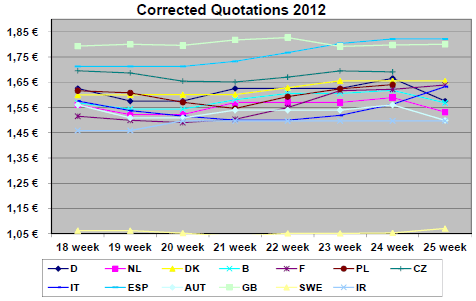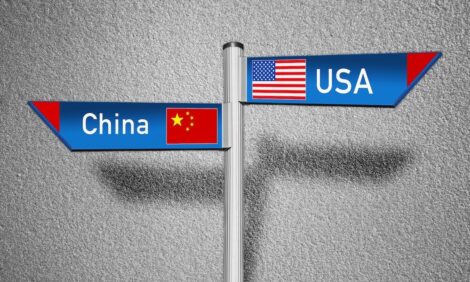



EU Pig Prices: German Companies Cause Slide in Prices
EU - After the clear -9 cents’ price correction in Germany, the EU slaughter pig markets are split in two this week.On the one hand, the countries that do not quote in a way following Germany continue to show a friendly trend. So the price could be maintained on the 10-years’ high in Spain. In France the quotation slightly went up by +2 cents as a result of the quantities on offer being scarce. The situation continues to be friendly in Italy. The offer remains below the previous year’s level whereas demand increases for seasonal reasons at the same time.
Denmark as well proves to be unimpressed by the German slide in prices. The prices in Denmark thus exceed the German prices by 8 cents. Last week the fact became known that Danish Crown inked a profitable contract concluded with China’s largest meat trading business, Shineway. By that, exports towards China should be growing considerably over the next months.
On the other hand, there are those countries whose markets are strongly influenced by the German pig price. Those countries clearly got into the maelstrom of decreasing prices. The price fell by -6 cents in Austria and by -5 cents in Belgium.
From the ISN’s point of view, the large slaughter companies’ massive influence on the pig price became clear last week. By short-term reductions of the numbers of pigs slaughtered at a few major slaughter companies, the capacities could not be run to full extent for as long as a week, but along with the relevant promotion, the price level could be lowered considerably.
At the same time, Germany’s price reduction is regarded as a tit-for-tat response by many market participants to the previous week’s price increase rather than as the result of supply and demand. This assumption is supported by the increasing distance between the German price and the quotations of other major pork exporters such as Spain or Denmark. It is a regrettable fact that German slaughter companies obviously strive for increasing their margin by lowering the purchase prices in the first place instead of raising the value creation in sales. Denmark described as an example above shows that there are also other ways.
Trend for the German market: As a result of the major slaughter companies’ reducing the quantities of pigs slaughtered, there’s an overhang of pigs which even at the beginning of this week has not been completely sold. It is hard to assess currently how the slaughter companies’ demand will develop over the week and when it will be that the market will finally come free.
| Week | D | NL | DK | B | F | PL | CZ | IT | ESP | AUT | GB | SWE | IR |
|---|---|---|---|---|---|---|---|---|---|---|---|---|---|
| Week 18 | 1.626 | 1.561 | 1.600 | 1.569 | 1.516 | 1,617 | 1.686 | 1.576 | 1.713 | 1.561 | 1.794 | 1.062 | 1.459 |
| Week 19 | 1.576 | 1.522 | 1.601 | 1.544 | 1.499 | 1.608 | 1.698 | 1.538 | 1.713 | 1.509 | 1.801 | 1.062 | 1.459 |
| Week 20 | 1.576 | 1.522 | 1.601 | 1.544 | 1.490 | 1.571 | 1.660 | 1.516 | 1.713 | 1.509 | 1.796 | 1.052 | 1.497 |
| Week 21 | 1.626 | 1.570 | 1.602 | 1.581 | 1.503 | 1.546 | 1.651 | 1.500 | 1.733 | 1.540 | 1.818 | 1.039 | 1.497 |
| Week 22 | 1.626 | 1.570 | 1.629 | 1.606 | 1.550 | 1.593 | 1.671 | 1.500 | 1.768 | 1.540 | 1.828 | 1.051 | 1.497 |
| Week 23 | 1.626 | 1.570 | 1.656 | 1.606 | 1.617 | 1.624 | 1,695 | 1.500 | 1.804 | 1.540 | 1.793 | 1.051 | 1.497 |
| Week 23 | 1.666 | 1.589 | 1.656 | 1.618 | 1.622 | 1.641 | 1.691 | 1.563 | 1.822 | 1.561 | 1.798 | 1.053 | 1.497 |
| Week 23 | 1.576 | 1.532 | 1.656 | 1.569 | 1.639 | 0 | 0 | 1.633 | 1.822 | 1.499 | 1.801 | 1.071 | 1.497 |
| Prices in Euros (€) | |||||||||||||

Explanation
1corrected quotation: The official Quotations of the different countries are corrected, so that each quotation has the same base (conditions).
base: 56 per cent lean meat; farm-gate-price; 79 per cent killing out percentage, without value-added-tax (VAT)







